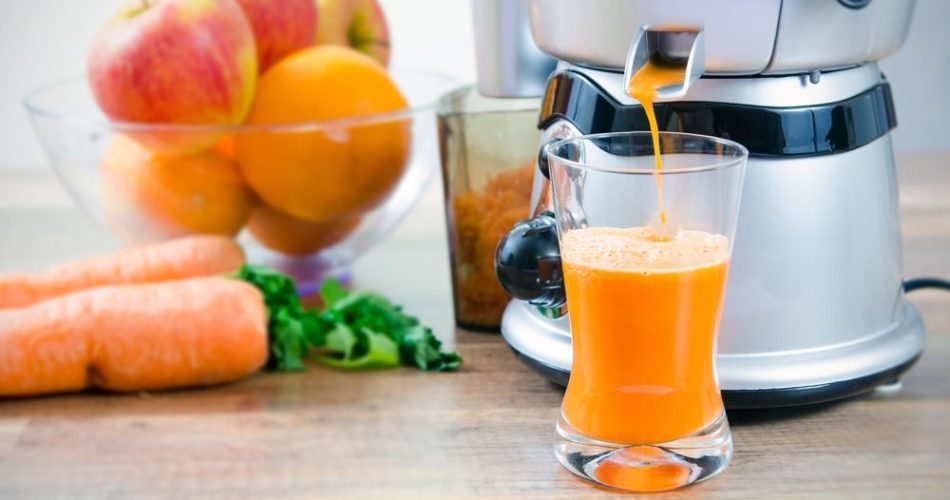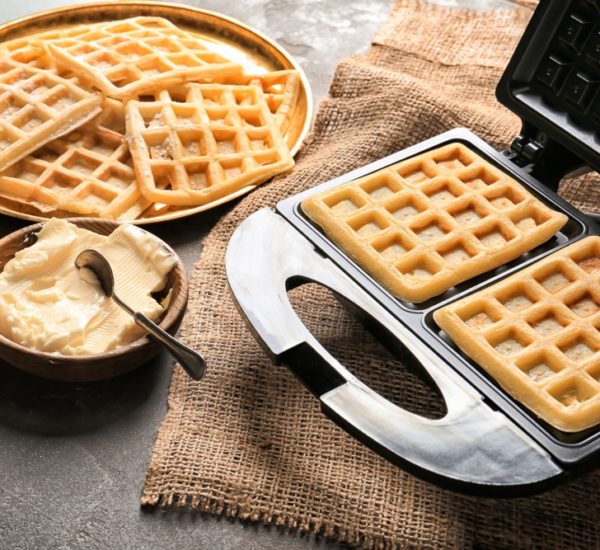If you’re like me, juicing has always been one of those things that sounds good in theory, but its practice seems a little daunting. My first experience with juicers was in high school, and back then, the early models promised a lot but delivered very little—little juice for the effort and a lot of mess. It’s a good thing times have changed. Today’s juicers are luckily not your mom’s from back in the day. With so many health benefits to juicing, I decided to give it a shot. Because I am very conscious of cost, I set a goal to find the best juicer under $100. I accomplished my goal with change to spare! Here’s what I discovered on my road to juicing bliss.
The Top 6 Juicers Under $100
The Mueller Austria Juicer
This juicer’s design is sleek and low-profile, so even when left on the kitchen counter, it does not take up too much space. This model boasts two speeds that can accommodate both soft fruits and vegetables such as tomatoes and oranges and harder fruits and vegetables such as apples and celery. Its 3” feed chute is large enough to allow for more fruits and vegetables to be juiced in a short amount of time.
Pros
- Sleek design and low-profile
- Easy to assemble and easy to understand instructions
- Two speeds that can accommodate both soft and harder fruits and vegetables
- 3” large feed chute
Cons
- Clean-up not very easy
- Spillage can also be an issue
Takeaway
The issues for this juicer seem to be minimal, and with slight user alterations, it can produce a fair amount of juice quickly and efficiently. It’s certainly in contention for one of the top juicers under 100.
Cuisinart CCJ-500 Citrus Juicer
For those of you who really only want a citrus juicer, this model does the job of making orange, lemon, grapefruit, or any other kind of citrus juice a whole lot easier. Back in the day, a wood reamer was used to extract juice from citrus fruits, and the process was very tedious and time-consuming because the reamer was a tool that required the user to squeeze the juice manually. Enter the Cuisinart CCJ-500.
Pros
- Stainless steel body and compact size
- Extracts a lot more juice and has three pulp control settings
- Innovative “Final Spin” feature extracts additional juice from the remaining pulp left in the reamer after the fruit has been removed
- Does not make a lot of noise
- All the removable parts are dishwasher safe
Cons
- More appropriate for smaller batches of juice
- Base tends to slide
Takeaway
The Cuisinart brand is known for producing good quality appliances at an affordable price point. Still, the buyer should be aware that this particular model is better for smaller citrus juice quantities and nothing else.
NXONE Slow Masticating Juicer
While researching the top juicers under 100, I discovered that the main difference between slow (or masticating) and fast (or standard centrifugal juicers) is their approach. Masticating juicers crush fruits and vegetables to produce juice, while standard juicers operate with high spinning blades to extract juice, making the model heat up quickly.
Pros
- The components are plastic and are less likely to cut you
- Quick and easy to assemble, disassemble, and wash
- Components are dishwasher safe
- Noise level is low
- Can close the spout that pours the juice into your glass so that it doesn’t spill
Cons
- Since it is slower, it does take longer to make juice
- The parts are plastic, so there may be an issue of wear after time
Takeaway
The NXONE Slow Juicer is a little pricier than the other juicers, but in keeping with my goal, it is still one of, if not the best masticating juicer under $100. The assembly and clean-up are easy, and if you can wait a little longer for your juice, you should be happy with this model.
Hamilton Beach Pro Juicer
Many of us have owned or used a Hamilton Beach product at some point in our lives as they produce a wide assortment of small and larger appliances. However, because it is a well-known brand, there is added pressure to deliver due to its reputation. This juicer works hard to do that.
Pros
- Large 3” feed chute
- BPA free
- Easy to clean
Cons
- Softer fruits leave dampness
- Very loud
Takeaway
This juicer is easy to clean if done immediately after juicing. As a juicer under $100, the model is good for someone new to the lifestyle and who just wants to learn and understand the basics quickly.
Breville BJE200XL Compact Centrifugal Juicer
Since I don’t have much counter space in my kitchen, this juicer’s compact design caught my eye. This model works well in preserving my precious counter real estate.
Pros
- Locking feature ensures the juicer won’t work until all the pieces are in place
- Includes scrub brush to aid in the clean up of the mesh and other removable parts
- The lidded measuring cup is helpful to catch liquid
- The pulp also comes out dry
Cons
- Leaking issue with pitted fruits and vegetables
- Not meant for bulk juicing
Takeaway
This model is durable and lasts for years. Just note that as a compact juicer, it’s not meant to be used as a bulk workhorse. But it is a great choice as an affordable juicer under $100.
Sagnart 2 in 1 Slow Masticating Citrus Juicer
Here is another candidate for the best masticating juicer under $100. What piqued my interest about it was the 2-in-1-feature. What was it, and would it make a difference in value?
Pros
- Easy to assemble and disassemble
- Easy to follow instruction book
- Can handle harder vegetables such as beets and fibrous celery
- Unit is quiet
- Compact
Cons
- May need to run fruits and vegetables through more than once
- No true 2-in-1-feature
Takeaway
From what I can tell, the 2-in-1-feature is the apple corer/cutter included with this model. This compact slow juicer is powerful for its size and produces a fair amount of juice. Just be sure to read the instruction book to get the most benefit out of this model. It is a good candidate for harder vegetables like celery.
Buying Guide for the Best Juicer for Under $100
Here are a few things to consider as I wrap up my juicer journey:
What are your juicing needs?
Will you be using the juicer for citrus juice only, or do you plan to juice various fruits and vegetables? This is important to determine as buying a juicer with all the bells and whistles doesn’t really make sense if you only want to use it for orange juice. If that is the case, a more basic citrus juicer should do the trick.
However, if you’d like to juice harder and/or more fibrous vegetables such as beets or celery, determine which models are equipped to handle them.
How often do you plan to use it?
Realize that there is effort involved in juicing. Depending on the kind of juicer you choose, it does take time, so your choice should reflect your desired amount of usage.
What are your must-have features?
For example, do you need a large feed chute, or are you looking for a juicer that is easy to assemble and easy to clean up after? When you know what you want, consider what you don’t want (like a juicer that is too noisy, bulky, or difficult to clean).
How experienced are you with juicing?
If you are a beginner, it’s best to choose an appropriate juicer for your expertise level. Sometimes the number of features offered can be confusing. While you may view many features for a low price as a great deal, realize that even a basic juicer can provide tremendous benefits and suit your needs just fine.
How important are the design and size to you?
Consider where the juicer will be placed and/or stored. Do you have enough counter space for a larger model, or do you require compact size, should you decide to leave it on display?
What is important to you?
While doing my research for the best juicer under $100, I’ve found that for me, clean up and ease of use are my big factors. I don’t want to take a lot of time to clean my juicer, and I also don’t want the clean up to be difficult. But I have to do my part in the maintenance. Clean up can be quick if the pieces are soaked right after use, and a plastic bag is used in the pulp bin. Also, utilizing the cleaning tools that come with the model should make cleaning up easier.
In terms of ease of use, I would like a model that is easy to assemble, easy to break down to clean, and of course, easy to use. I know now that for my part, I should cut the fruits and vegetables into smaller pieces so that the juicer doesn’t jam and heat up due to overwork. Remember that since you’re looking for a juicer under $100, do not expect to get everything that a $300 model offers.
FAQs
What is the difference between a slow masticating juicer and a centrifugal juicer? A slow juicer slowly crushes fruits and vegetables, while a centrifugal juicer uses blades to extract juice quickly.
What is the best way to clean a juicer?
Use a plastic bag in the pulp bin to reduce the clean up and soak parts in soapy water immediately after use. More tips can be found in the instructions included with the juicers.
Can celery be juiced?
What are the best juicers for greens like kale and spinach? The answer depends on the model you choose. Note which juicers mention the type of vegetables or fruits you want to use in their description to determine capability.
What is the reverse feature?
The reverse feature allows the blades to spin in reverse so that lodged vegetables and fruit can be dislodged. This feature can help the juicer run properly, and it can make cleaning easier.
How often should a juicer be cleaned?
A juicer should be cleaned after each use, even if you plan to use it for the same type of juice the next time. Unwashed parts will cause the unit to stop working. Leftover pulp will harden and clog the juicer, making it difficult to use. It can even cause it to break.
What do I do if my juicer doesn’t work or breaks down?
Contact the company’s customer service department for help or more information.
Final Thoughts
I have really enjoyed researching and learning about different types of juicers, the updated features today’s models now offer, and determining my must-haves in my search for the best juicer under $100. After doing my research, now it’s just a matter of picking which works best for thrifty me—or, as I like to call it, the fun part.










